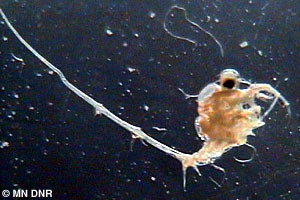A new study released by the U.S. Fish and Wildlife Service examines possible routes by which the invasive zooplankton species, spiny waterflea, might reach Lake Champlain, as well as options for trying to prevent such spread. The spiny waterflea is an invasive zooplankton species. To date, no invasive zooplankton have been found in Lake Champlain. The spiny waterflea is currently found in Great Sacandaga Reservoir in Fulton and Saratoga Counties, NY, just south of the Champlain Basin and with a short water link to the Champlain Canal.
The study determined that the spiny waterflea is most likely to reach Lake Champlain in a recreational boat travelling between the two water bodies, stating, “based on the biology of the Spiny Waterflea, there is a low probability it will spread from Great Sacandaga Lake to Lake Champlain through the Champlain Canal. Although spiny waterflea has been detected in riverine environments, their preferred habitat is a deep lake environment. If detected in the Sacandaga or Hudson rivers, it is not likely that the spiny waterflea would persist long enough to travel an estimated 50 miles from Great Sacandaga Lake to Lake Champlain. There is higher likelihood that the SWF will be spread to Lake Champlain via human activities.”
The study reinforces the importance of personal responsibility for preventing the spread of invasive species. Boaters must ensure that their crafts are clean and free of weed fragments, residual water in live wells and bait buckets, and other potential sources of invasive species. All boaters must take steps to personally help protect the ecological integrity of our waters.
